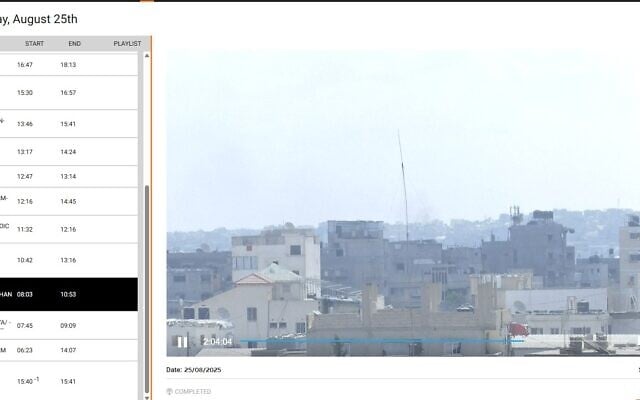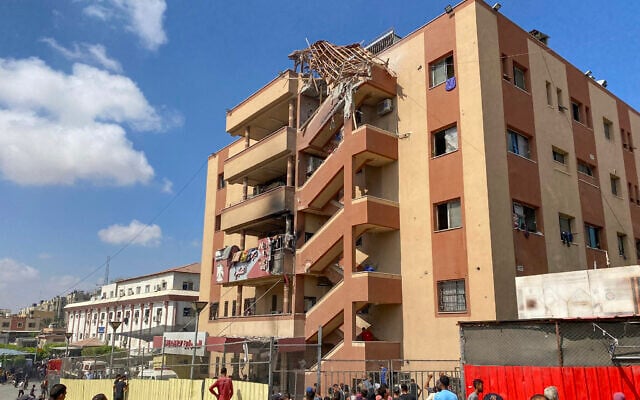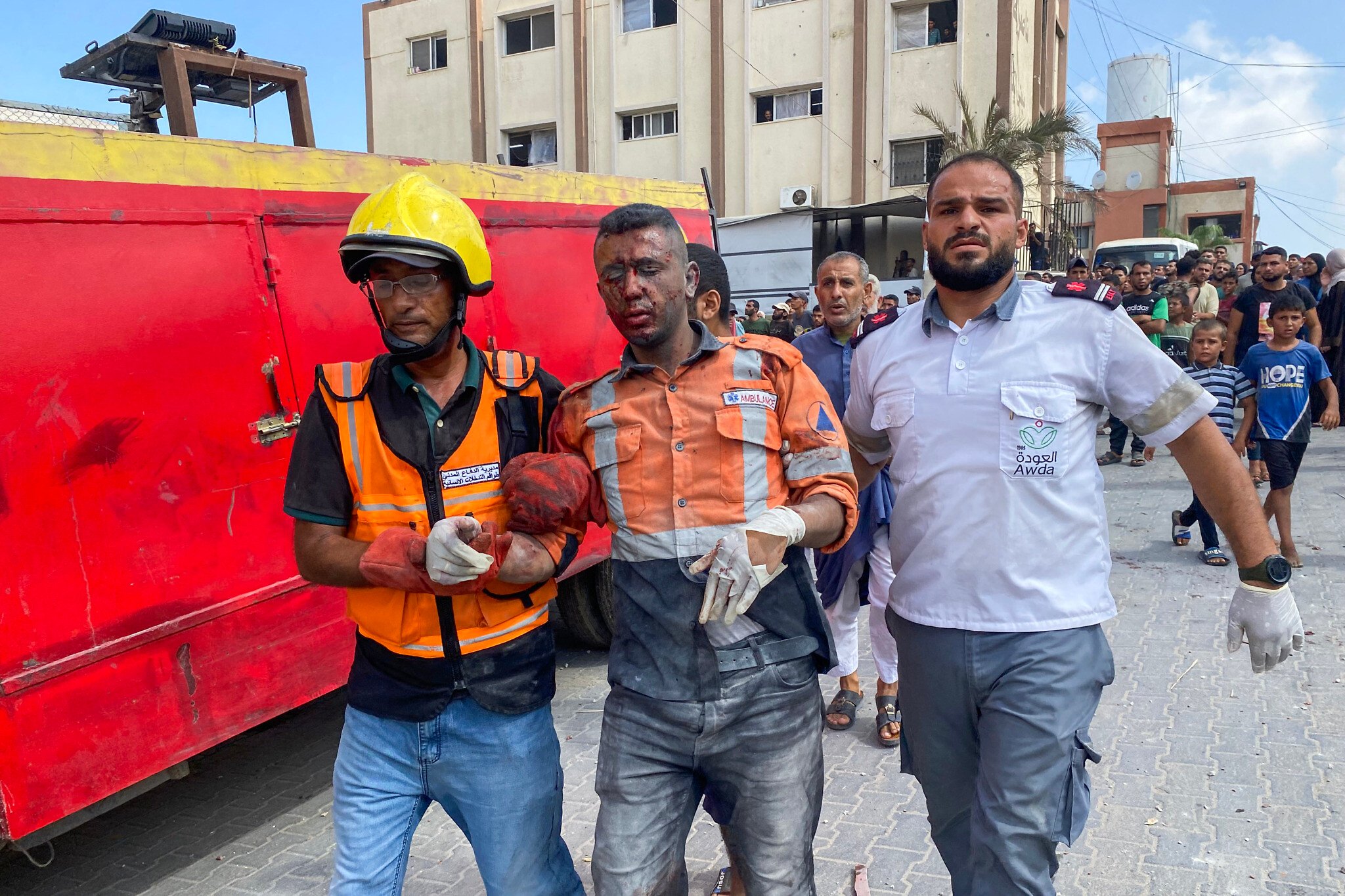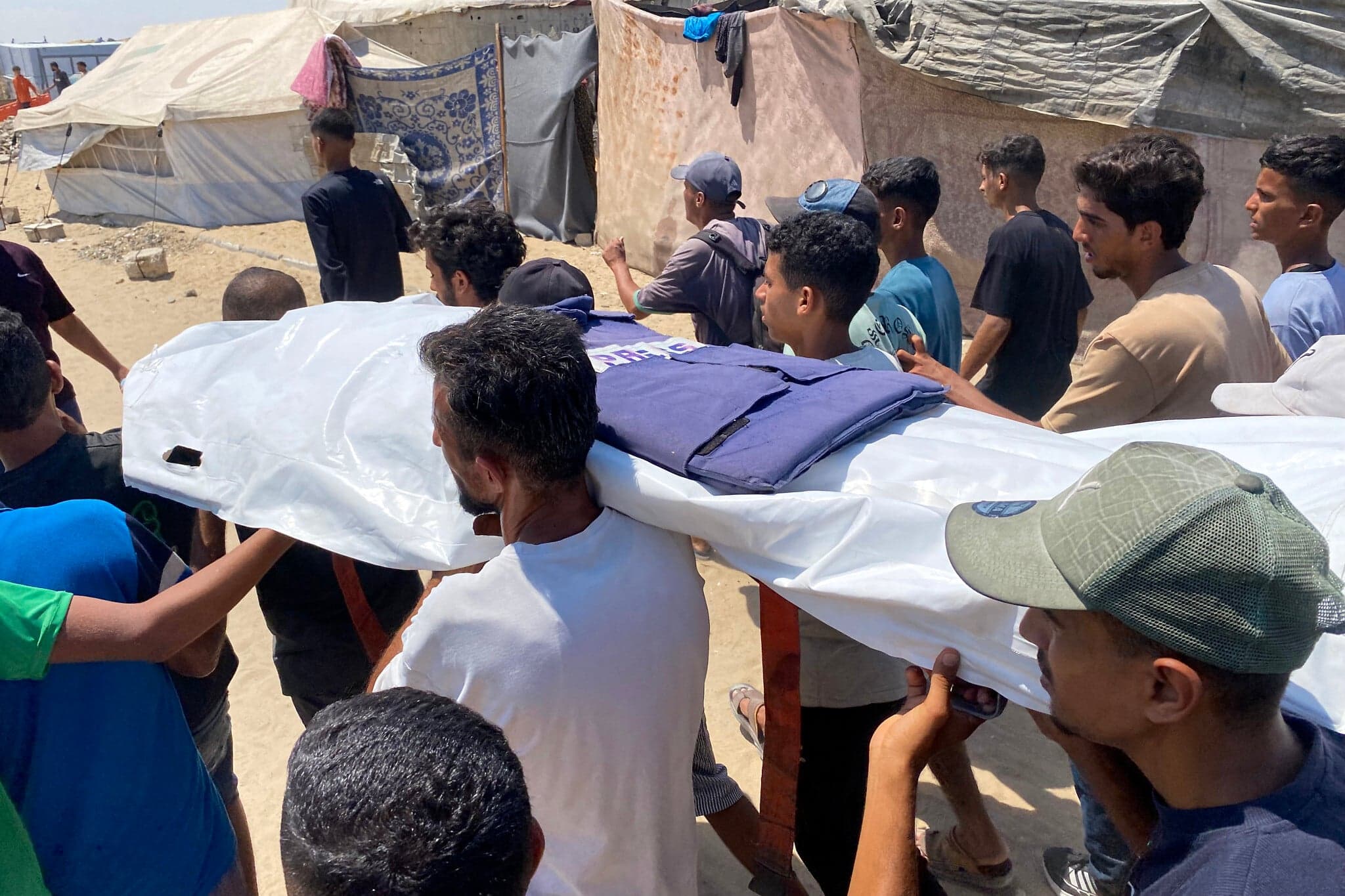Tank shelling carried out by the Israeli military on Nasser Hospital in the Khan Younis area of the southern Gaza Strip on Monday morning killed at least 20 people, including five journalists, according to media reports and the Hamas-run health ministry.
The Israel Defense Forces, some three hours after the reports of the attack emerged, confirmed that troops had carried out a strike in the area.
Footage showed rescue workers, who had arrived at the site of an initial attack, engulfed in smoke and debris when a second strike hit. Witnesses said journalists and other people had also rushed to the site of the first strike.
A military official told The Times of Israel that the attack was not conducted by the Israeli Air Force, indicating it was likely carried out by ground forces.
IDF Chief of Staff Lt. Gen. Eyal Zamir ordered an immediate inquiry into the strike, the military said, without providing further details.
“The IDF regrets any harm to uninvolved [civilians] and in no way directs strikes at journalists,” the IDF said, adding that it works to “minimize harm to them while safeguarding the security of our forces.”
One of the Israeli strikes on the Nasser hospital complex was captured on live video as rescue crews arrived at the scene of an Israeli strike minutes before.
— Trey Yingst (@TreyYingst) August 25, 2025
Military officials told Hebrew-language media outlets that an Israeli army tank team shelled a camera stationed at the hospital, believing the device was being used to track troops.
Two shells were fired by the tank, with the first targeting the camera and the second hitting rescuers who were operating at the scene.
According to the Foreign Press Association, the strikes “hit the exterior staircase of the hospital where journalists frequently stationed themselves with their cameras.”
Reuters said its journalist, Hussam al-Masri, had been operating a live video feed from the hospital, which suddenly shut down at the moment of the initial strike.
Reuters and other news providers often deliver live video feeds to media outlets worldwide during major news events to show the scene from the ground in real time. Reuters had frequently broadcast a feed from Nasser hospital during the Gaza conflict, and for the past several weeks had been delivering daily feeds from the Nasser hospital position that was hit.

A review of Masri’s live feed from before the strike did not appear to show any soldiers.
The IDF has not confirmed the details of the reports.
Previously, the military has said that striking sensitive sites in Gaza, such as hospitals, requires the approval of senior officers, including the chief of the Southern Command and the IDF chief of staff.
The army’s investigation is set to include the question of who approved the strike.
According to the Foreign Press Association, the strikes “hit the exterior staircase of the hospital where journalists frequently stationed themselves with their cameras. The strikes came with no warning.”
“We demand an immediate explanation from the Israel Defense Forces and the Israeli Prime Minister’s Office. We call on Israel once and for all to halt its abhorrent practice of targeting journalists,” the group said, leveling an accusation that Israel strenuously denies.

“This has gone on far too long. Too many journalists in Gaza have been killed by Israel without justification,” the statement continued, noting that “Israel continues to block international journalists from independent access to Gaza.
“This must be a watershed moment. We appeal to international leaders: do everything you can to protect our colleagues. We cannot do it ourselves,” the association concluded.
Journalists affiliated with Reuters, AP, and Al Jazeera killed
Cameraman Hussam al-Masri, a Reuters contractor, was killed in the first strike, according to Palestinian officials. Photographer Hatem Khaled, who was also a Reuters contractor, was wounded in a second strike on the hospital, they said.
“We are devastated to learn of the death of Reuters contractor Hussam al-Masri and injuries to another of our contractors, Hatem Khaled, in Israeli strikes on the Nasser hospital in Gaza today,” a Reuters spokesperson said in a statement.
Masri operated a Reuters live video feed from the hospital, which suddenly shut down at the moment of the initial strike, Reuters reported. The news agency said it had frequently broadcast a feed from Nasser Hospital during the Gaza conflict, and for the past several weeks had been delivering daily feeds from the position that was hit.
“We are urgently seeking more information and have asked authorities in Gaza and Israel to help us get urgent medical assistance for Hatem,” the Reuters spokesperson said.
استشهاد أربعة صحفيين باستهداف مستشفى ناصر في #غزة
حسام المصري، مصور صحفي مع وكالة رويترز للأنباء.
محمد سلامة، مصور صحفي مع قناة الجزيرة.مريم أبو دقة، صحفية مع عدة وسائل إعلام بينها اندبندنت عربية وAP.
معاذ أبو طه، صحفي مع شبكة NBC الأمريكية. pic.twitter.com/bphE5WfZbp— Khaled Drareni (@khaleddrareni) August 25, 2025
The Associated Press said it was “shocked and saddened” to learn of the death of Mariam Dagga, 33, a visual journalist who freelanced for the agency since the start of the war.
Health officials in Gaza named the other two journalists as Mohammed Salama, who Qatar-based Al Jazeera said worked for the broadcaster, and Moaz Abu Taha.
A rescue worker was also among those killed, the health officials added.
Palestinian journalists group says 240 killed since war’s start
The Palestinian Journalists Syndicate condemned Israel for the strikes, saying it represented “an open war against free media, with the aim of terrorizing journalists and preventing them from fulfilling their professional duty of exposing its crimes to the world.”
According to the group, more than 240 Palestinian journalists have been killed by Israeli fire in Gaza since the war started on October 7, 2023 with the Hamas terror group’s invasion, massacre, and hostage-taking in southern Israel.

Israel, which says it has no policy of targeting journalists, has asserted that some of the journalists killed throughout the war were in fact combatants. In some cases, the military has provided documentation seized from terror groups in Gaza that list the journalists as fighters.
Hospitals have been frequent sites of fighting in the Gaza war.
Top Hamas official Ismail Barhoum was killed in a strike at Nasser Hospital in March. In May, a prominent Palestinian journalist, accused of being a Hamas operative, was killed in a strike at the Khan Younis medical center.
Hamas has in the past held hostages at Nasser Hospital, according to the IDF. Shifa Hospital, in the north of the Strip, was also used by Hamas to hold some hostages and as a command-and-control center early in the war, and was the site of fierce battles between Hamas fighters and IDF troops.
COGAT publishes graphic footage of Hamas hurting Gazans
Also Monday, the Defense Ministry’s Coordinator of Government Activities in the Territories (COGAT) published graphic footage it said depicts Hamas gunmen “beating, abusing, and shooting at Gaza residents across the Strip.”
According to COGAT, the footage has circulated on social media in recent days. COGAT did not provide any further details on the videos.
“Hamas embodies the essence of evil. The shocking footage illustrates how the terrorist organization Hamas oppresses the population, abuses civilians, and uses unrestrained violence against people in order to maintain its bloody rule and consolidate its power,” said COGAT chief Maj. Gen. Ghassan Alian in a post on X.
“Hamas once again proves that it does not represent the residents of Gaza — it rules over them with force, fear, and cruelty,” he added.

